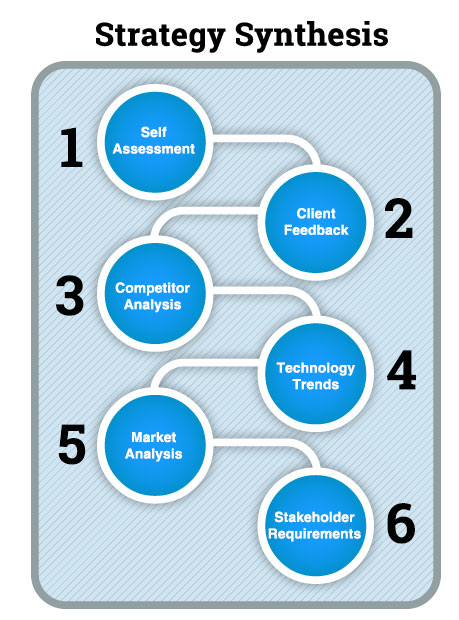Before putting pen to paper and writing a proposal or investor pitch, it is best if you do your homework first. Developing a winning strategy first requires a codified process consisting of 6 steps followed by a synthesis shown in the figure below.

STEP 1 – SELF-ASSESSMENT – A thorough understanding of the organization’s strengths, weaknesses and assets/resources available to it with an emphasis on its people, product, and proposed processes.
STEP 2 – CLIENT FEEDBACK – Intelligence from prospective clients on their current problems and the value your new product will bring to their organization.
STEP 3 – COMPETITOR ANALYSIS – The strengths, weaknesses and strategy of competitors’ products fighting for the same market space.
STEP 4 – TECHNOLOGY TRENDS – An awareness of competing and emerging technologies that could disrupt the strategy
STEP 5 – MARKET ANALYSIS – A thorough knowledge of market and industry trends
STEP 6 – STAKEHOLDER REQUIREMENTS – A clear understanding of additional stakeholder requirements which could include regulatory, political and social factors that could positively or negatively affect the market acceptance of your product.
Once you have done the research by collecting the disparate data and information in steps 1-6, you can then synthesize it into actionable intelligence on which to make decisions and write a compelling proposal or investor pitch.
Developing a winning strategy is a Biotech company’s first major challenge requiring in-depth knowledge of both technology and business. In the case of startup company led by a business entrepreneur, he/she is usually partners with a chief technology officer to oversee the technology portion of the strategy.
Armed with this information, a business strategy can be formulated consisting of several thrusts designed to allocate the company’s limited resources to protect and exploit its technology, compete in a favorable market space, and recruit and retain top-level talent. The most important focus of the strategic planning process is making decisions on where to allocate scarce resources. Too many young organizations get bogged down on the process and writing the plan and lose sight of the real importance of the planning process which is to make tough decisions about where to allocate resources. This 6 step process will help you target your limited resources to where they are needed most and will be a key success factor in your ability to obtain the funding needed to begin or continue operations.
For a more in-depth discussion of this topic, read Leading Science and Technology Organizations: Mastering the Fundamentals of Personal, Managerial, and Executive Leadership.



Leave A Comment